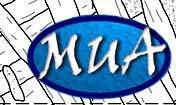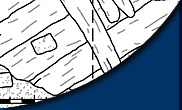

Seminole, Alabama: Recording a
19th Century Sidewheel Steamboat
2-6 June 2008
By I. Franklin and W. Abrahamson
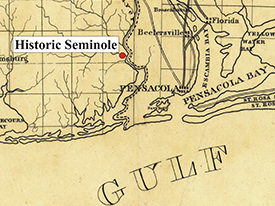
Location of Seminole wreck on a 1836 historic map. (Large View)
The first week of field school took place in Seminole, Alabama on a 19th century sidewheel steamboat. The Seminole Wreck is a side-wheel paddle steamship located in the Blackwater River near the historic lumber town of Seminole in South Alabama. It lies in a north-south orientation with the starboard paddlewheel hub and starboard edge of the hull and main deck exposed. The remainder of the ship's hull, main deck, steam engine, walking beam, A-frame, and rudder remains intact under the surface of the river. This well-preserved wreck represents only a handful of remaining examples of American steamboat construction that are still accessible for study today. By using stringent archaeological recording methods, interviewing local informants, studying unique features on the wreck and the archaeological documentation on other known side-wheel steamship wrecks, it appears that this ship was built around 1870. It was probably built in New York, and brought down to the area for use in the local lumber industry sometime in the mid to late 1920s.
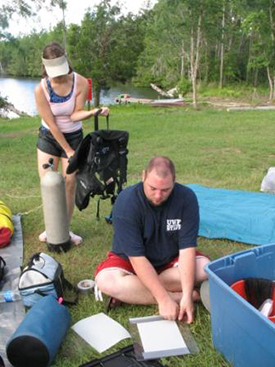
Jake and Amanda preparing for their dive at Seminole.
Seminole is an ideal location for students to master the skills learned during last week’s Scientific Diver Training Workshop. The students were divided into 4 teams of 3 and assigned different areas of the wreck to record and map. Throughout the week, each team made 7 dives on the wreck and created detailed scale drawings of their specific area.
Team 1: Jake, Chris, and Amanda:
Team 1 was assigned the task of recording the bow that is between 4-8 meters on the baseline. The team recorded the wreck’s double hull, dimensions of two hatches and associated crossbeams, measured floor timbers, and documented knee pattern. After the hull dimensions were drawn to scale, the team changed their focus to the boiler face. They cleaned and removed corrosion off the boiler face, in order to uncover and document the boiler’s bolt pattern. Next, the port side of the boiler was investigated.
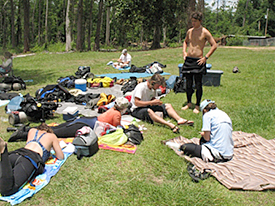
Students taking field notes between dives.
Team 2: Ashley, Bryce, and Brian
Team 2 was assigned the task of recording the bow section of the steamboat that was from 0-4 meters on the baseline. Measurements of the inner and outer hull were taken from the baseline every ½ meter. Hull fastener patterns were also documented. A profile drawing of the winch, walking beam, and hatches were created. The team also gathered small samples of a wooden plug and sheathings for analysis.
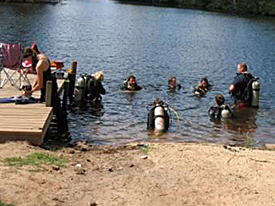
Wayne briefing divers at dock.
Team 3: Scott, Eric, and Jenn
Team 3 was assigned the task of recording two stern hatches. Measurements were gathered for the dimensions of each hatch and incorporated into a planview of the stern. The team also laid out a baseline from the boiler to the stern of the steamship. After the stern hatches had been identified, the team photographed, measured, and drew a hinge found near one of the stern hatches.
Team 4: Colleen, Lynne, and Hans
Team 4 was assigned the stern face of the boiler as their task. Throughout the week this team gathered overall dimensions of the boiler and piece plotted features such as handles, knobs, and pipes. The team also searched for a boiler plaque but did not find any remaining evidence.
Overall, this week at Seminole was a great success. The weather was sunny and partly cloudy with a nice breeze all week. Students became proficient in archaeological recording and mapping techniques as well as communicating with their dive teams underwater.
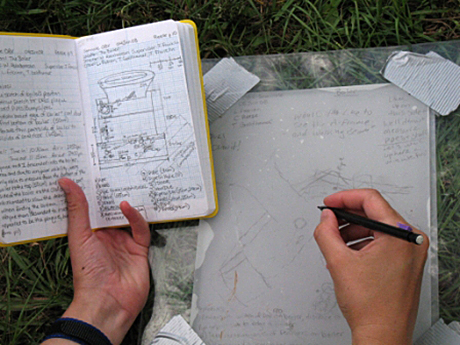
Field notes and drawing of wreck's boiler.
Please feel free to contact us if you have any questions or concerns at: mua@keimaps.com.
Return to Project Journal home page.
